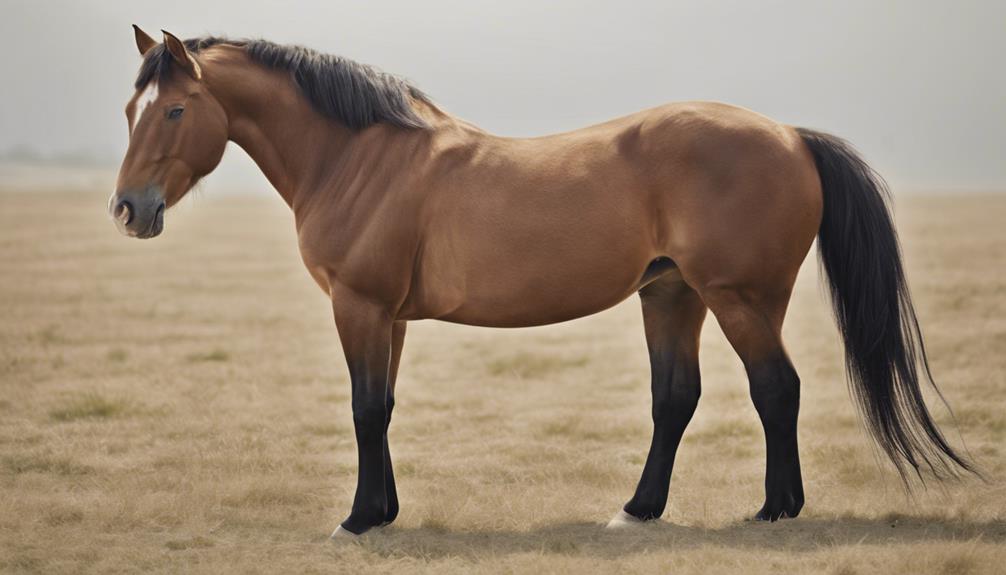Why Do Horses Show Signs of Aggression?
Have you ever pondered why horses, known for their grace and beauty, sometimes exhibit signs of aggression?
It's a complex topic that delves into various aspects of equine behavior and psychology. Understanding the reasons behind a horse's aggressive behavior can provide valuable insights into their needs and help you build a better relationship with these majestic animals.
From triggers that set off aggressive reactions to the subtle cues in a horse's body language, exploring the root causes of aggression in horses can lead to more effective ways of managing and preventing such behavior.
Understanding Aggression in Horses
Understanding aggression in horses involves observing their body language and reactions in various situations to determine their behavior patterns. By examining the aggression origins, you can gain insight into why a horse may display aggressive behavior. Some common causes include fear, pain, dominance, or even past traumatic experiences. Behavioral management plays a crucial role in addressing and minimizing aggression in horses.
When addressing aggression origins, it's essential to consider any underlying factors that may be triggering such behavior. Horses may exhibit aggression when they feel threatened or when their personal space is invaded. Identifying these triggers can help in implementing effective behavioral management strategies to address the issue. Behavioral management techniques such as positive reinforcement, desensitization, and establishing clear boundaries can be effective in modifying aggressive behavior in horses.
To effectively manage aggression in horses, it's crucial to establish a consistent and structured routine. Horses thrive on predictability and stability, so maintaining a stable environment can help reduce stress and prevent aggressive outbursts. Additionally, providing ample opportunities for exercise and social interaction can help channel their energy in a positive way. By understanding the origins of aggression and implementing appropriate behavioral management techniques, you can create a harmonious relationship with your horse while ensuring a safe and comfortable environment for both of you.
Common Signs of Aggression
If you notice a horse displaying aggressive behavior, it's important to be aware of common signs that may indicate aggression. Here are some key behaviors to watch for:
- Ears pinned back: When a horse flattens its ears against its head, it often signifies aggression. This is a clear sign that the horse is unhappy or irritated.
- Baring teeth: Horses may bare their teeth as a warning sign before escalating to more aggressive behavior. It's crucial to address this behavior promptly.
- Tail swishing: A horse swishing its tail aggressively may indicate agitation or frustration. This can be a precursor to more overt signs of aggression.
- Charging or kicking: Direct acts of aggression like charging or kicking are serious signals that the horse is feeling threatened or dominant. Immediate action is necessary to prevent harm.
Understanding these common signs can help you manage aggressive behavior effectively. By recognizing these cues early on, you can intervene before a situation escalates. Remember, aggression triggers can vary from horse to horse, so observing and understanding your horse's behavior is crucial for successful behavior management.
Triggers for Aggressive Behavior
Identifying the triggers that can lead to aggressive behavior in horses is essential for maintaining a safe environment for both you and your horse. Behavioral triggers are often rooted in fear, pain, or past negative experiences. Horses may become aggressive when they feel threatened, cornered, or when their personal space is invaded. Understanding your horse's individual triggers is crucial in preventing aggressive outbursts.
Environmental factors can also play a significant role in triggering aggression in horses. Factors such as overcrowding, limited access to resources like food or water, and uncomfortable living conditions can lead to stress and subsequently aggressive behavior. Loud noises, sudden movements, and unfamiliar surroundings can also provoke a horse and trigger aggression.
It's important to pay attention to your horse's body language and reactions to different situations to identify potential triggers for aggression. By recognizing and addressing these triggers, you can help your horse feel more comfortable and secure, reducing the likelihood of aggressive behavior. Providing a calm and consistent environment, ensuring access to necessities, and addressing any underlying health issues are key steps in mitigating behavioral triggers and creating a harmonious relationship with your horse.
Body Language of Aggressive Horses
Aggressive horses often display distinct body language cues that signal their discomfort or hostility towards a situation or individual. Understanding these cues is crucial for recognizing and potentially mitigating aggressive behavior in horses. Here are some key body language signals to watch out for:
- Aggressive Postures: Horses may adopt specific postures when feeling aggressive, such as pinning their ears back flat against their head, raising their head high, baring their teeth, or kicking out. These postures indicate a readiness to defend themselves or assert dominance.
- Communication Signals: Horses use various communication signals to express aggression, including rapid tail swishing, stomping their feet, excessive snorting, or even charging towards a perceived threat. These signals serve as warnings to potential aggressors to back off.
- Intense Staring: Aggressive horses may fixate their gaze on the target of their aggression, maintaining intense eye contact as a way to assert dominance or intimidate the other party.
- Flared Nostrils: Flaring nostrils accompanied by a tense facial expression can indicate heightened arousal and potential aggression in horses. This physiological response prepares the horse for a fight-or-flight response, with aggression being a likely choice in this context.
Aggression Vs. Dominance in Horses
When observing horses, understanding the distinction between aggression and dominance is essential for interpreting their behavior accurately. Aggression in horses typically involves hostile actions or threats, often arising from fear, pain, or frustration. On the other hand, dominance is about control over resources and space within the herd. Horses establish a dominance hierarchy through social interactions, where individuals display dominant behaviors to assert their rank.
In the equine world, dominance is a natural part of herd dynamics. Horses establish a pecking order to maintain order within the group. Dominant behaviors can include controlling access to food, water, or preferred resting spots. It's crucial to recognize that dominance in horses isn't always aggressive; it's a way for them to establish leadership and prevent conflicts. Understanding this distinction can help you better comprehend your horse's actions and reactions.
In a herd setting, dominant horses often lead the group, making decisions about when to move, graze, or rest. They also have priority access to resources, ensuring their survival. Submissive horses, on the other hand, yield to the dominant ones, reducing tension and minimizing conflicts. By observing these interactions, you can gain insight into the social structure of the herd and better understand your horse's behavior within that context.
Handling Aggression in Horses
To address aggression in horses effectively, establish clear boundaries and consistent training methods. When dealing with aggressive behavior in your horse, it's important to handle the situation with care and patience. Here are some key points to consider:
- Training Techniques: Utilize positive reinforcement methods to encourage good behavior and discourage aggression. Consistent and gentle training can help your horse understand what's expected of them.
- Establish Clear Communication: Horses are highly sensitive animals, so it's crucial to communicate clearly and effectively. Use body language and voice commands to convey your expectations.
- Behavioral Therapy: Consider seeking the help of a professional trainer or equine behaviorist to address underlying issues causing aggression in your horse. They can provide insights and guidance on how to modify your horse's behavior effectively.
- Consistent Handling: Maintain a consistent approach when interacting with your horse. Inconsistencies in handling can confuse your horse and lead to further behavioral problems.
Health Issues and Aggression

Addressing potential health issues is crucial in understanding and managing aggression in horses. When it comes to health concerns, horses may exhibit aggressive behavior as a way of expressing discomfort or pain. Behavioral patterns such as biting, kicking, or even charging can often be linked to underlying health issues that need to be addressed promptly.
One common health issue that can lead to aggression in horses is dental problems. Dental pain or discomfort can cause horses to act out aggressively, especially when pressure is applied to the bit or when chewing becomes painful. Regular dental check-ups and maintenance can help prevent such issues and subsequently reduce aggressive behaviors.
Additionally, digestive problems like gastric ulcers can also contribute to aggressive tendencies in horses. The discomfort caused by ulcers can make horses irritable and prone to lashing out. Monitoring feeding habits, providing a balanced diet, and addressing any digestive issues promptly can help alleviate aggressive behavior stemming from such health concerns.
Training to Manage Aggressive Behavior
Understanding how to effectively train and manage aggressive behavior in horses is essential for creating a safe and harmonious environment for both the horse and handler. Here are some key strategies to help you in behavior modification and aggression prevention:
- Positive Reinforcement: Utilize rewards such as treats or praise to encourage good behavior and discourage aggression.
- Consistent Training: Establish clear boundaries and consistently enforce them to prevent confusion and frustration in your horse.
- Desensitization Techniques: Gradually expose your horse to triggers that may cause aggression, helping them learn to remain calm in challenging situations.
- Seek Professional Help: If you're struggling to manage your horse's aggression, don't hesitate to seek assistance from a qualified trainer or behaviorist who can provide specialized guidance.
Frequently Asked Questions
Can Aggression in Horses Be Genetic or Inherited From Their Parents?
Aggression in horses can be influenced by genetic predisposition. While inherited traits play a role, behavioral training also impacts their behavior.
Do Certain Breeds of Horses Display Aggression More Than Others?
Certain breeds of horses may display varying levels of aggression due to temperament differences. Training techniques play a crucial role in managing and mitigating potential aggression in horses.
Understanding breed tendencies can help tailor training methods to address specific behaviors. By recognizing these differences and applying appropriate training strategies, you can effectively work with your horse to foster a harmonious relationship and decrease the likelihood of aggressive displays.
Can a Horse's Diet and Nutrition Play a Role in Their Aggressive Behavior?
If your horse is showing signs of aggression, consider how their diet and nutrition might be impacting their behavior. Dietary imbalances can lead to stress and affect their mood. Make sure they're getting the right nutrients.
Additionally, evaluate their exercise routine and provide proper behavioral training to help manage their aggression. By addressing these factors, you can help your horse maintain a balanced and calm demeanor.
Are There Any Natural Remedies or Supplements That Can Help Calm an Aggressive Horse?
If you're looking to calm an aggressive horse, there are natural remedies and calming supplements available. These products can aid in horse behavior modification by promoting relaxation and reducing stress.
When considering how to address your horse's aggression, incorporating these natural solutions into their routine may help create a more peaceful environment for both you and your horse.
How Do Environmental Factors, Such as Living Conditions and Social Interactions, Impact a Horse's Tendency Towards Aggression?
Influence on a horse's aggression can stem from environmental factors like living conditions and social interactions. Training methods and socialization play vital roles in shaping behavior. Exercise routines and handling techniques also impact a horse's demeanor.
Positive social interactions and proper training can help reduce aggression in horses. Providing a suitable living environment and implementing effective handling methods are key in managing a horse's tendencies towards aggression.
Conclusion
In conclusion, understanding the reasons behind a horse's aggression is key to managing their behavior effectively. By recognizing common signs, triggers, and body language, you can address the root cause of their aggression.
It's important to differentiate between aggression and dominance in horses, and seek professional help if needed. With proper training and care, you can help your horse overcome their aggressive tendencies and build a strong, trusting relationship with them.
